In our Irish Country Living Holidaying at Home series earlier this summer, we tried to promote the road less travelled. So, why, I hear you ask, are you in Killarney, surely one of the busiest tourist hotspots in the country?
Kerry is a very popular destination in Ireland, with good reason. Ask Google why you should visit and you will be told about the stunning coastline, rich culture, history, heritage and outdoor activities. Ask Artificial intelligence (AI) ChatGPT and it will also commend the outdoor activities: fishing, swimming, kayaking, cycling, and hiking. But while the AI does allude to an abundance of restaurants and pubs in Killarney, there is very little (if anything) mentioned about the quality of the food.
In fact, sustenance following your activities appears to be something of an afterthought in selling the charms of the town. With this omission in mind, and differentiating food-focused accommodation from the mass of hotels stretching out from the centre to the national park, Cahernane House has taken inspiration from the past for its modern-day menu. But we will come back to that.
Cahernane Chronicles
The original staircase of Cahernane House ascends behind the reception desk, where on check-in, you are handed a key, not a card – a nod to the property’s past life.
General Manager, Emer Corridan meets with me to discuss the history of the house as well as our reason for travelling to Kerry: for their “Taste of Cahernane” experience.
“Henry Herbert returned to Ireland from Australia in 1861 with a fortune made breeding sheep for wool and training horses for export to India,” she explains. “During his time at home, he fell in love with Catherine Elizabeth Stewart from nearby Muckross House, who, unfortunately for Henry, did not return his interest. Not to be deterred, he travelled to the United States, and on his return, Catherine decided to reciprocate his affections, but wanted a bigger house. They might say money can’t buy you love, but in this case, it certainly helped, with Henry rebuilding Cahernane House in 1875.”
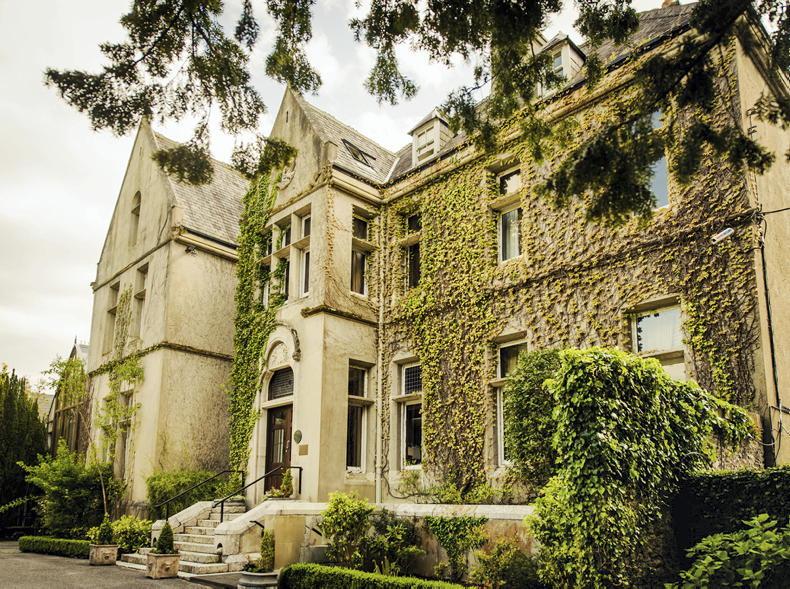
Henry Herbert rebuilt Cahernane House in 1875.
The couple went on to have one son and four daughters, including Katherine, who published a memoir in 1949 (titled Bricks and Flowers), and Gwendolyn, whose ghost, it is said, still roams the house on occasion. Despite the ghost stories, Emer tells me she had no qualms about being the hotel’s sole resident during the bad days of COVID-19. In fact, she found comfort and escape in her home from home. Nonetheless, with a lifetime of hospitality in her veins, she was thrilled to get back to welcoming visitors.
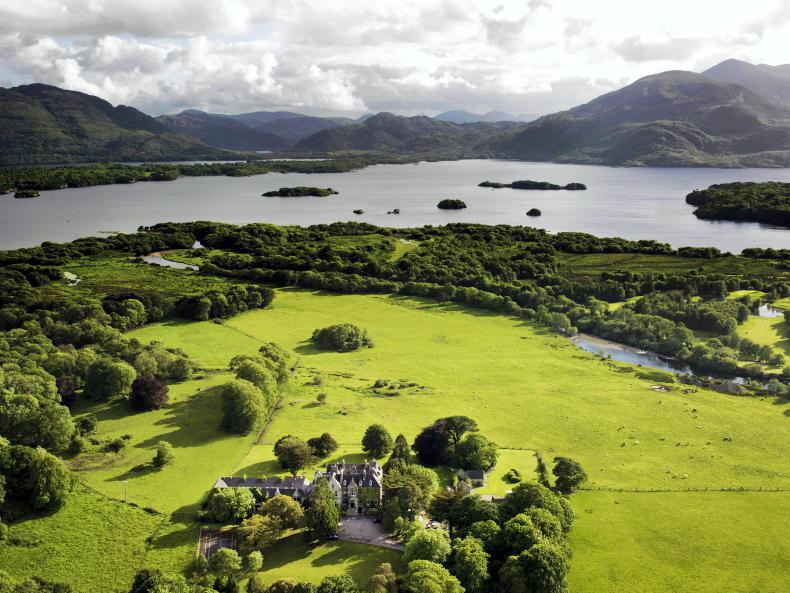
Irish Country Living took a trip to Killarney
With the Herbert family falling on hard times, many proprietors (including a local cattle farmer at one point) have taken ownership of the property over the last 125 years. It was, however, the current owners (International Hotel Management Company PREM Group) that completed the most recent extensive renovation just before COVID-19.
After our chat, Emer and I walked out into the 6.4ac grounds to the coach house, a stand-alone accommodation adjacent to the main hotel. This 19th century-stone building once housed the horse-drawn carriages of its earlier function, and has since been reimagined and converted into eight more bedrooms, bringing the total number of rooms to 48.
Emer praises interior designer Julie Goggin, who worked on the manor house and the coach house, for creating “truly unique depictions of Kerry” for their guests. Each room is bespoke with amazing feature wallpapers and luxurious matching fabrics on throws, cushions and chairs, which are strewn across original Irish antique furniture. Matching colourful rotary telephones in each room set off the aesthetic perfectly.
Cahernane cuisine
Relatively new to the helm of the historic property, executive chef Cormac Vesey discovered a menu from the 1960s in the old store kitchen at Cahernane.
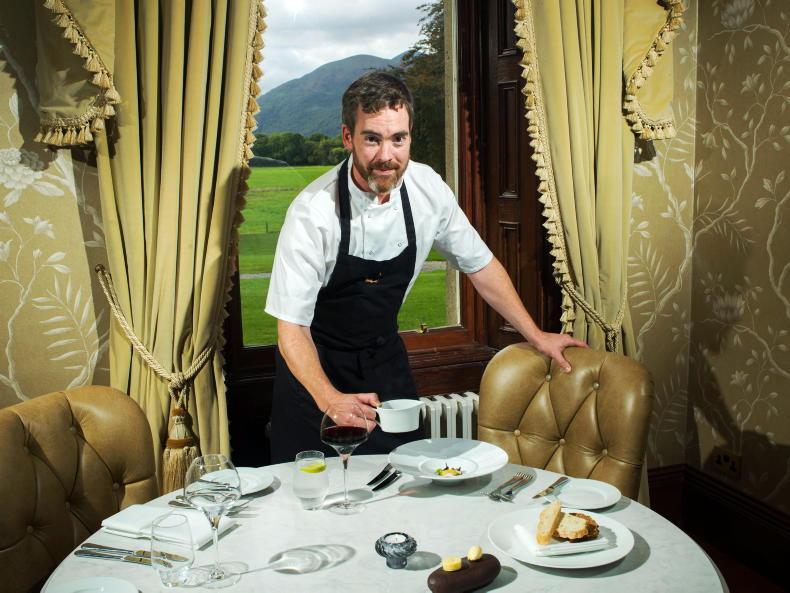
It was executive chef Cormac Vesey that discovered a menu from the 1960s in the old store kitchen at Cahernane.
Having worked internationally, as well as in some of Ireland’s finest hotels, Cormac was able to take inspiration from this remnant of a past time to create a modern “Taste of Cahernane”.
The extensive old menu offered a plethora of choices to the Cahernane House guest of the 60s, with an emphasis on seasonal local produce. Cormac’s modern take continues this ethos, which he explains, “focuses on fresh, local ingredients, as eating what is growing now is going to be the best thing on your plate”.
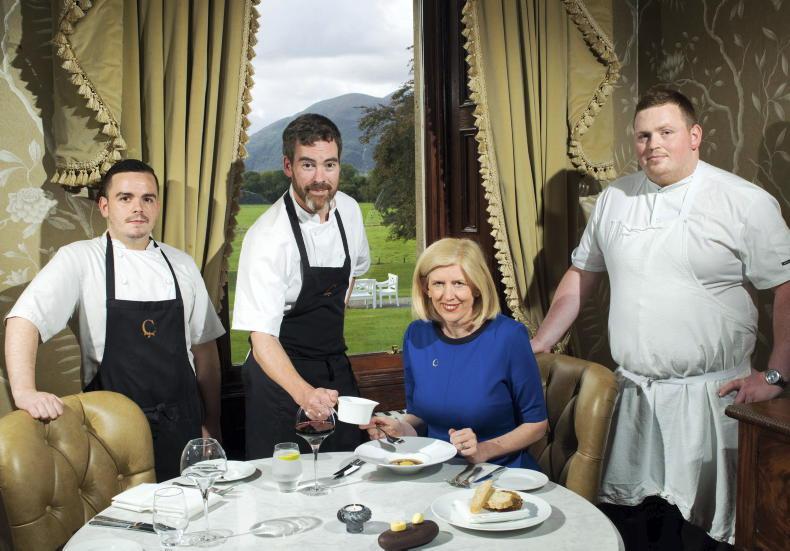
The team at Cahernane House including Emer Corridan and Cormac Vesey
Even before we enter the Herbert Restaurant, local sourcing is evident: our welcome drink is a Muckross Gin gimlet. Although each course was delectable, the lobster au gratin with Kells Bay dilisk sabayon and charred leek was my personal highlight.
The 1960s menu reveals a number of differences and similarities to Cahernane House’s modern menu:
• Like the Mars bar, it is smaller: It is rare to see as extensive a menu nowadays, as a shorter menu sheds complexity and cost. Preparing and purchasing the same ingredients saves time and cash. It also allows a chef to perfect dishes.
• Veal is – or at least, was – special: The old menu offered a selection of 15 specialities, of which six were beef and five were veal. I found this notable in that veal is rarely seen on a menu now. You would think in our health-conscious times that this light, low-fat, easy-to-cook meat would be more popular, particularly in a dairy-producing country. Instead, it is much more likely that a third of a menu would be made up of chicken (of which there was only one, very expensive option on the 1960s menu: Coq au Vin Rouge).
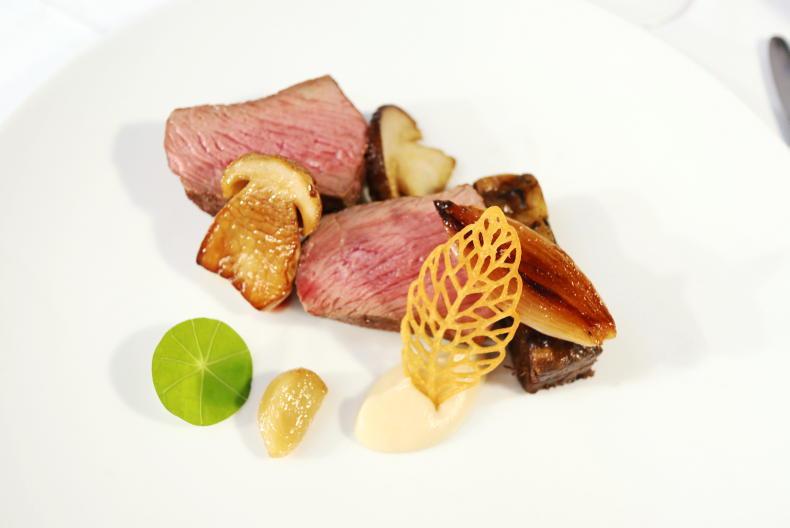
Irish Country Living took a trip to Killarney
• Prices also were eye-opening in the past: A fillet steak was 13/6 (in old money), which I calculate as €46 today when corrected for inflation. Veal strips with mushrooms, cream and wine sauce were the same price: 13 shillings and sixpence.
•Be nice to your waiter! The menu reads: “We wish to inform you, dear patron, that to continue our standard of excellent food for which we are well known, you play a big part by having patience with us and by being prepared to wait some time. All our dishes are made fresh and time is needed to produce the exacting standard and quality we offer. Delays can occur when a variety of dishes are ordered by a party and also between courses.”
When it comes to good food, patience is a virtue and in Cahernane House, no wait is too long.
Gourmet getaway €179.50 pps.
Book www.cahernane.com
In our Irish Country Living Holidaying at Home series earlier this summer, we tried to promote the road less travelled. So, why, I hear you ask, are you in Killarney, surely one of the busiest tourist hotspots in the country?
Kerry is a very popular destination in Ireland, with good reason. Ask Google why you should visit and you will be told about the stunning coastline, rich culture, history, heritage and outdoor activities. Ask Artificial intelligence (AI) ChatGPT and it will also commend the outdoor activities: fishing, swimming, kayaking, cycling, and hiking. But while the AI does allude to an abundance of restaurants and pubs in Killarney, there is very little (if anything) mentioned about the quality of the food.
In fact, sustenance following your activities appears to be something of an afterthought in selling the charms of the town. With this omission in mind, and differentiating food-focused accommodation from the mass of hotels stretching out from the centre to the national park, Cahernane House has taken inspiration from the past for its modern-day menu. But we will come back to that.
Cahernane Chronicles
The original staircase of Cahernane House ascends behind the reception desk, where on check-in, you are handed a key, not a card – a nod to the property’s past life.
General Manager, Emer Corridan meets with me to discuss the history of the house as well as our reason for travelling to Kerry: for their “Taste of Cahernane” experience.
“Henry Herbert returned to Ireland from Australia in 1861 with a fortune made breeding sheep for wool and training horses for export to India,” she explains. “During his time at home, he fell in love with Catherine Elizabeth Stewart from nearby Muckross House, who, unfortunately for Henry, did not return his interest. Not to be deterred, he travelled to the United States, and on his return, Catherine decided to reciprocate his affections, but wanted a bigger house. They might say money can’t buy you love, but in this case, it certainly helped, with Henry rebuilding Cahernane House in 1875.”

Henry Herbert rebuilt Cahernane House in 1875.
The couple went on to have one son and four daughters, including Katherine, who published a memoir in 1949 (titled Bricks and Flowers), and Gwendolyn, whose ghost, it is said, still roams the house on occasion. Despite the ghost stories, Emer tells me she had no qualms about being the hotel’s sole resident during the bad days of COVID-19. In fact, she found comfort and escape in her home from home. Nonetheless, with a lifetime of hospitality in her veins, she was thrilled to get back to welcoming visitors.

Irish Country Living took a trip to Killarney
With the Herbert family falling on hard times, many proprietors (including a local cattle farmer at one point) have taken ownership of the property over the last 125 years. It was, however, the current owners (International Hotel Management Company PREM Group) that completed the most recent extensive renovation just before COVID-19.
After our chat, Emer and I walked out into the 6.4ac grounds to the coach house, a stand-alone accommodation adjacent to the main hotel. This 19th century-stone building once housed the horse-drawn carriages of its earlier function, and has since been reimagined and converted into eight more bedrooms, bringing the total number of rooms to 48.
Emer praises interior designer Julie Goggin, who worked on the manor house and the coach house, for creating “truly unique depictions of Kerry” for their guests. Each room is bespoke with amazing feature wallpapers and luxurious matching fabrics on throws, cushions and chairs, which are strewn across original Irish antique furniture. Matching colourful rotary telephones in each room set off the aesthetic perfectly.
Cahernane cuisine
Relatively new to the helm of the historic property, executive chef Cormac Vesey discovered a menu from the 1960s in the old store kitchen at Cahernane.

It was executive chef Cormac Vesey that discovered a menu from the 1960s in the old store kitchen at Cahernane.
Having worked internationally, as well as in some of Ireland’s finest hotels, Cormac was able to take inspiration from this remnant of a past time to create a modern “Taste of Cahernane”.
The extensive old menu offered a plethora of choices to the Cahernane House guest of the 60s, with an emphasis on seasonal local produce. Cormac’s modern take continues this ethos, which he explains, “focuses on fresh, local ingredients, as eating what is growing now is going to be the best thing on your plate”.

The team at Cahernane House including Emer Corridan and Cormac Vesey
Even before we enter the Herbert Restaurant, local sourcing is evident: our welcome drink is a Muckross Gin gimlet. Although each course was delectable, the lobster au gratin with Kells Bay dilisk sabayon and charred leek was my personal highlight.
The 1960s menu reveals a number of differences and similarities to Cahernane House’s modern menu:
• Like the Mars bar, it is smaller: It is rare to see as extensive a menu nowadays, as a shorter menu sheds complexity and cost. Preparing and purchasing the same ingredients saves time and cash. It also allows a chef to perfect dishes.
• Veal is – or at least, was – special: The old menu offered a selection of 15 specialities, of which six were beef and five were veal. I found this notable in that veal is rarely seen on a menu now. You would think in our health-conscious times that this light, low-fat, easy-to-cook meat would be more popular, particularly in a dairy-producing country. Instead, it is much more likely that a third of a menu would be made up of chicken (of which there was only one, very expensive option on the 1960s menu: Coq au Vin Rouge).

Irish Country Living took a trip to Killarney
• Prices also were eye-opening in the past: A fillet steak was 13/6 (in old money), which I calculate as €46 today when corrected for inflation. Veal strips with mushrooms, cream and wine sauce were the same price: 13 shillings and sixpence.
•Be nice to your waiter! The menu reads: “We wish to inform you, dear patron, that to continue our standard of excellent food for which we are well known, you play a big part by having patience with us and by being prepared to wait some time. All our dishes are made fresh and time is needed to produce the exacting standard and quality we offer. Delays can occur when a variety of dishes are ordered by a party and also between courses.”
When it comes to good food, patience is a virtue and in Cahernane House, no wait is too long.
Gourmet getaway €179.50 pps.
Book www.cahernane.com












 This is a subscriber-only article
This is a subscriber-only article









SHARING OPTIONS: